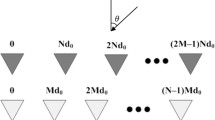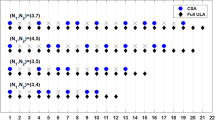Abstract
Direction of arrival (DOA) estimation using co-prime array has been attractive for its potential advantages. A co-prime array consists of two uniform linear arrays (ULAs), where one has M elements with \(N\lambda /2\) being the inter-element spacing, and the other has N (co-prime to M) elements with \(M\lambda /2\) being the inter-element spacing . In this paper, the two ULAs of the co-prime array are placed parallel to each other in the same plane for two-dimensional (2D) DOA estimation, and the uniqueness proof of DOA estimation for this geometry is given. By setting the vectorization of the cross covariance matrix of the two ULAs as an observing vector in sparse representation, MN degrees of freedom (DOF) can be achieved via (\(M+N)\) sensors. Then through the enhanced sparse recovery technique, unique and automatically paired 2D DOA estimation can be obtained from the recovery vector via only 1D dictionary. The proposed algorithm can achieve better DOA estimation performance than conventional algorithms. The simulation results verify the effectiveness of the proposed algorithm.








Similar content being viewed by others
References
Bekkerman, I., & Tabrikian, J. (2006). Target detection and localization using MIMO radars and sonars. IEEE Transactions on Signal Processing, 54(10), 3873–3883.
Cao, H., Yang, L., Tan, X., et al. (2009). Computationally efficient 2-D DOA estimation using two parallel uniform linear arrays. ETRI Journal, 31(6), 806–808.
Cao, J., Zhang, K., Luo, M., Yin, C., & Lai, X. (2016). Extreme learning machine and adaptive sparse representation for image classification. Neural Networks, 81, 91–102.
Cao, J., Zhao, Y., Lai, X., Ong, M. E. H., Yin, C., Koh, Z. X., et al. (2015). Landmark recognition with sparse representation classification and extreme learning machine. Journal of the Franklin Institute, 352(10), 4528–4545.
Cheng, Z., Zhao, Y., Li, H., et al. (2015). Two-dimensional DOA estimation algorithm with co-prime array via sparse representation. Electronics Letters, 51(25), 2084–2086.
Ewout, V. D. B., & Friedlander, M. P. (2008). Probing the Pareto frontier for basis pursuit solutions. Siam Journal on Scientific Computing, 31(2), 890–912.
Gershman, A. B., Rübsamen, M., & Pesavento, M. (2010). One-and two-dimensional direction-of-arrival estimation: An overview of search-free techniques. Signal Processing, 90(5), 1338–1349.
Hu, N., Ye, Z., Xu, X., & Bao, M. (2013). DOA estimation for sparse array via sparse signal reconstruction. IEEE Transactions on Aerospace and Electronic Systems, 49(2), 760–773.
Kikuchi, S., Tsuji, H., & Sano, A. (2006). Pair-matching method for estimating 2-D angle of arrival with a cross-correlation matrix. IEEE Antennas and Wireless Propagation Letters, 5(1), 35–40.
Li, J., & Zhang, X. (2015). Sparse representation-based joint angle and Doppler frequency estimation for MIMO radar. Multidimensional Systems and Signal Processing, 26(1), 179–192.
Li, J., Zhang, X., & Chen, H. (2012). Improved two-dimensional DOA estimation algorithm for two-parallel uniform linear arrays using propagator method. Signal Processing, 92(12), 3032–3038.
Luo, X., Fei, X., Wei, P., et al. (2014). Sparse representation-based method for two-dimensional direction-of-arrival estimation with L-shaped array. In 2014 IEEE international conference on communication problem-solving (ICCP) (pp. 277–280).
Malioutov, D., Cetin, M., & Willsky, A. S. (2005). A sparse signal reconstruction perspective for source localization with sensor arrays. IEEE Transactions on Signal Processing, 53(8), 3010–3022.
Moffet, A. (1968). Minimum-redundancy linear arrays. IEEE Transactions on Antennas Propagation, 16(2), 172–175.
Ottersten, B., Stoica, P., & Roy, R. (1998). Covariance matching estimation techniques for array signal processing applications. Digital Signal Processing, 8, 185–210.
Pal, P., & Vaidyanathan, P. P. (2011). Coprime sampling and the music algorithm. In Digital signal processing workshop and IEEE signal processing education workshop (DSP/SPE) (pp. 289–294). IEEE.
Pal, P., & Vaidyanathan, P. P. (2010). Nested arrays: A novel approach to array processing with enhanced degrees of freedom. IEEE Transactions on Signal Processing, 58(8), 4167–4181.
Sidiropoulos, N. D., Giannakis, G. B., & Bro, R. (2000). Blind PARAFAC receivers for DS-CDMA systems. IEEE Transactions on Signal Processing, 48, 810–823.
Song, S. J., Shin, H. J., & Jang, Y. H. (2002). Development of an ultra sonic phased array system for nondestructive tests of nuclear power plant components. Nuclear Engineering and Design, 214(1), 151–161.
Stoica, P., Babu, P., & Li, J. (2011). SPICE: A sparse covariance-based estimation method for array processing. IEEE Transactions on Signal Processing, 59(2), 629–638.
Tan, Z., & Nehorai, A. (2014). Sparse direction of arrival estimation using co-prime arrays with off-grid targets. IEEE Signal Processing Letters, 21(1), 26–29.
Tayem, N., & Kwon, H. M. (2005). L-shape 2-dimensional arrival angle estimation with propagator method. IEEE Transactions on Antennas and Propagation, 53(5), 1622–1630.
Vaidyanathan, P. P., & Pal, P. (2011). Sparse sensing with co-prime samplers and arrays. IEEE Transactions on Signal Processing, 59(2), 573–586.
Wang, F., Cui, X., & Lu, M. (2014). Decoupled 2D direction finding based on sparse signal reconstruction. In 2014 IEEE military communications conference (MILCOM) (pp. 306–311). IEEE.
Weng, Z., & Djurić, P. M. (2014). A search-free DOA estimation algorithm for coprime arrays. Digital Signal Processing, 24(1), 27–33.
Wu, Y., Liao, G., & So, H. C. (2003). A fast algorithm for 2-D direction-of-arrival estimation. Signal Processing, 83(8), 1827–1831.
Xia, T., Zheng, Y., Wan, Q., & Wang, X. (2007). Decoupled estimation of 2-D angles of arrival using two parallel uniform linear arrays. IEEE Transactions on Antennas and Propagation, 55(9), 2627–2632.
Xin, J., Zheng, N., & Sano, A. (2007). Simple and efficient nonparametric method for estimating the number of signals without eigendecomposition. IEEE Transactions on Signal Processing, 55(4), 1405–1420.
Yin, Q. Y., Newcomb, R. W., & Zou, L. H. (1989). Estimating 2-D angles of arrival via two parallel linear arrays. In IEEE international conference on acoustics, speech, and signal processing (pp. 2803–2806).
Yin, J., & Chen, T. (2011). Direction-of-arrival estimation using a sparse representation of array covariance vectors. IEEE Transactions on Signal Processing, 59(9), 4489–4493.
Zhang, Y. D., Amin, M. G., & Himed, B. (2013). Sparsity-based DOA estimation using co-prime arrays. In IEEE international conference on acoustics, speech and signal processing (ICASSP) (pp. 3967–3971). IEEE.
Zhou, C., Shi, Z., Gu, Y., et al. (2013). DECOM: DOA estimation with combined MUSIC for coprime array. In 2013 IEEE international conference on wireless communications and signal processing (WCSP) (pp. 1–5). IEEE.
Zoltowski, M. D., Haardt, M., & Mathews, C. P. (1996). Closed-form 2-D angle estimation with rectangular arrays in element space or beamspace via unitary ESPRIT. IEEE Transactions on Signal Processing, 44(2), 316–328.
Acknowledgments
This work is supported by National Natural Science Foundation of China (61371169), the Fundamental Research Funds for the Central Universities (2015B12614) and A Project Funded by the Priority Academic Program Development of Jiangsu Higher Education Institutions.
Author information
Authors and Affiliations
Corresponding author
Appendix
Appendix
As
From Eq. (17), it is shown that the mean of \(\Delta \mathbf{r}\) is 0. For the variance matrix of \(\Delta \mathbf{r}\), the \(i-\)th column of \({\hat{\mathbf{R}}}_C \) is
where \(x_{Ni}\left( t \right) \) is the i-th element of \(\mathbf{x}_N \left( t \right) \). According to Ottersten et al. (1998), the signals are independent from sample to sample and circularly Gaussian distributed. Then it can be derived that
where \(\hbox {R}_{Nji} \) is the (j,i)th element of covariance matrix \(\mathbf{R}_N =E[\mathbf{x}_N \left( t \right) \mathbf{x}_N^H \left( t \right) ]\), and \(\mathbf{R}_M =E[\mathbf{x}_M \left( t \right) \mathbf{x}_M^H \left( t \right) ]\). From Eq. (19), it can be derived that the variance matrix of \(\Delta \mathbf{r}\) is
Rights and permissions
About this article
Cite this article
Li, J., Jiang, D. & Zhang, X. Sparse representation based two-dimensional direction of arrival estimation using co-prime array. Multidim Syst Sign Process 29, 35–47 (2018). https://doi.org/10.1007/s11045-016-0453-9
Received:
Revised:
Accepted:
Published:
Issue Date:
DOI: https://doi.org/10.1007/s11045-016-0453-9




